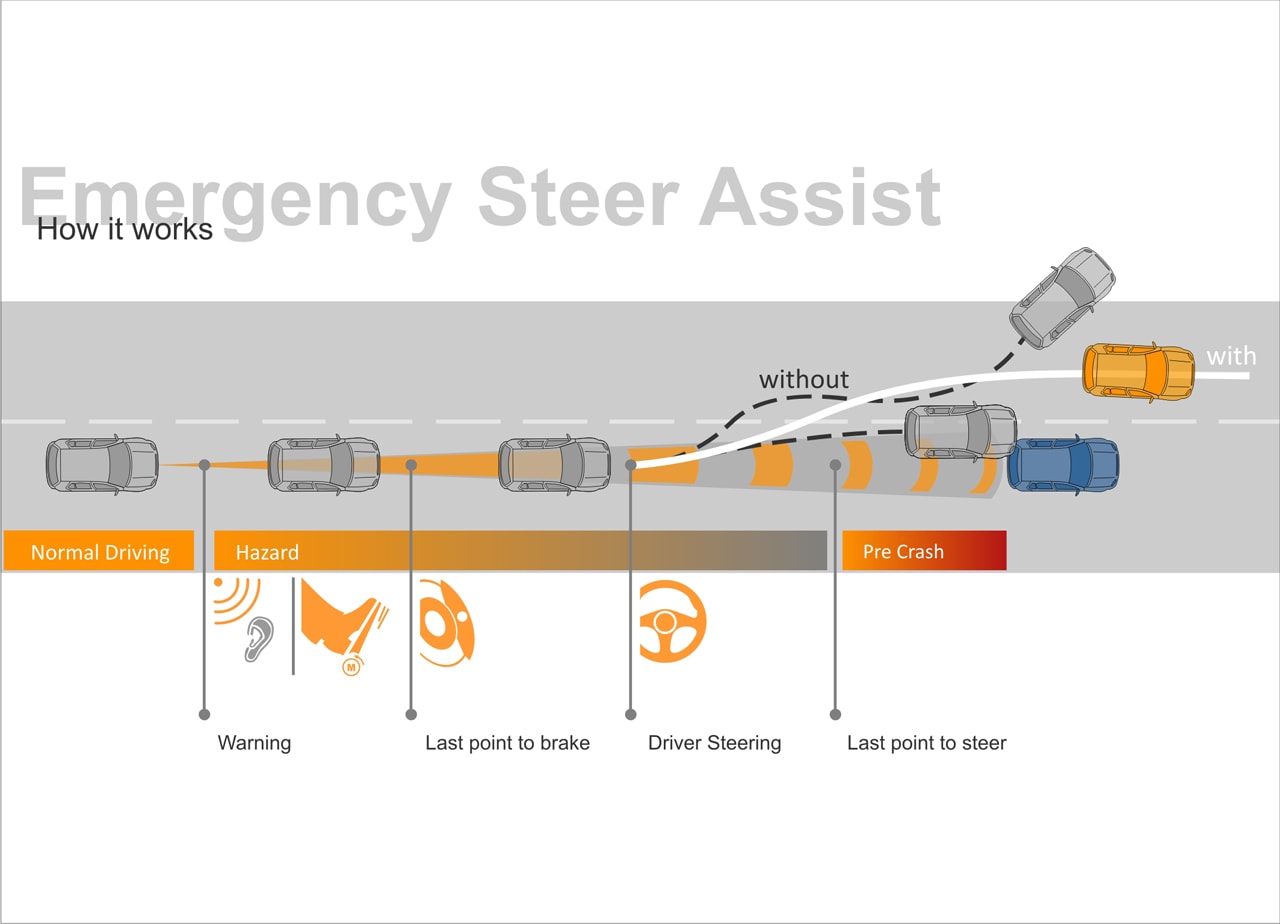The modern automobiles are fitted with a plethora of active safety systems that use an army of sensors and computers to help the driver during a hazardous situation. However, the longitudinal movement of the car has received much more attention from safety systems developers that the lateral dynamics.
The need for the driver to receive assistance during lateral movement becomes obvious in a situation where the car has already passed the point in which it could have braked to avoid an impact, regardless of the braking assist systems it is fitted with. This kind of event requires the driver to execute a steering maneuver in order to avoid the accident. And this is where assistance is required. But the systems currently offered on production vehicles only assist the braking maneuvers, while the Electronic Stability Control (ESC) just makes sure that the vehicle doesn’t steer out of control.
The international automotive supplier Continental has been studying this scenario and has come up with a system that supports obstacle-avoidance maneuvers. Called Emergency Steer Assist, the application uses sensors and systems which are already integrated on some of today’s vehicles.
The first action of the systems is to scan the road ahead of the vehicle by using the radar sensors of a vehicle’s Adaptive Cruise Control (AAC), also combining the information with that obtained from camera systems, like those used by the Intelligent Headlamp Control. The latter is an optional function, used for greater accuracy.
If the system determines that the car is dangerously approaching an obstacle, it enters a “safety mode”. Now the system’s aim is to offer the best road-holding ability to the vehicle. The next step prepares the vehicle’s ESC for keeping the car on the road during the rapid avoidance maneuver, stabilizing it by using early selective application of initial braking pressure to individual wheels. For vehicles equipped with active rollbars or adaptive suspensions, the system can offer additional assistance by bringing the aforementioned systems to the optimum tension levels.
However, the system only prepares the vehicle for the evasive maneuver, leaving the final choice to the driver. The person behind the wheel is warned that there is an imminent hazard, with the application using acoustical or haptic signals and applying an initial braking pressure or counter force in the accelerator pedal (when the vehicle is equipped with a device that allows this). If the drivers decides to perform the steering maneuver, the system instantly determines the optimum trajectory that should be followed and compares the perfect steering angle with the one applied by the driver and can assist the steering movement. The systems still allows the driver to take his own decision that would override its adjustments.
Continental stresses the fact that all the hardware necessary for the Emergency Steer Assist can already be found on series production vehicles, with the only question being how many of the required systems are available - as you’ve seen the Steer Assist is more effective if it can rely on a wider range of systems to “see” the road or control the car’s movement.
The ESC will become mandatory on all new vehicle models sold in the European Union starting from next year and on all new cars starting from 2014, while the system will be a standard requirement in all cars, trucks, SUVs and minivans by the 2012 model year in the U.S. In addition to that, Electric servo-assisted steering systems are becoming widespread. The only components that are not so common but are required by Continental’s system are the radar and video sensors, which are still a pricey option. The obstacle avoidance assistance system offers the highest level of support on vehicles equipped with an actively steered rear axle, but these are extremely rare.
The system can prove to be a very useful tool in saving lives and avoiding material damage, as theoretical calculations show that the distance at which the driver of a typical medium vehicle, traveling at a speed of 62 mph (100 km/h) on a dry road needs to start a braking maneuver in order to avoid an accident is about 40 meters. The same distance required for a successful evading maneuver is approximately 30 percent smaller. On a wet road, the gap between the two can increase up to 50 percent, so the driver has twice as much time to initiate an evasive maneuver than a braking one in order to avoid a collision. The calculations target relatively high speed driving and do not apply to most city areas, where braking is more effective, as the speeds have moderate values and adjacent lanes are not always free for the car to enter.
Continental announced that the Emergency Steer Assist is currently in the development stage and the production version of the system will be ready in two to three years.
The need for the driver to receive assistance during lateral movement becomes obvious in a situation where the car has already passed the point in which it could have braked to avoid an impact, regardless of the braking assist systems it is fitted with. This kind of event requires the driver to execute a steering maneuver in order to avoid the accident. And this is where assistance is required. But the systems currently offered on production vehicles only assist the braking maneuvers, while the Electronic Stability Control (ESC) just makes sure that the vehicle doesn’t steer out of control.
The international automotive supplier Continental has been studying this scenario and has come up with a system that supports obstacle-avoidance maneuvers. Called Emergency Steer Assist, the application uses sensors and systems which are already integrated on some of today’s vehicles.
The first action of the systems is to scan the road ahead of the vehicle by using the radar sensors of a vehicle’s Adaptive Cruise Control (AAC), also combining the information with that obtained from camera systems, like those used by the Intelligent Headlamp Control. The latter is an optional function, used for greater accuracy.
If the system determines that the car is dangerously approaching an obstacle, it enters a “safety mode”. Now the system’s aim is to offer the best road-holding ability to the vehicle. The next step prepares the vehicle’s ESC for keeping the car on the road during the rapid avoidance maneuver, stabilizing it by using early selective application of initial braking pressure to individual wheels. For vehicles equipped with active rollbars or adaptive suspensions, the system can offer additional assistance by bringing the aforementioned systems to the optimum tension levels.
However, the system only prepares the vehicle for the evasive maneuver, leaving the final choice to the driver. The person behind the wheel is warned that there is an imminent hazard, with the application using acoustical or haptic signals and applying an initial braking pressure or counter force in the accelerator pedal (when the vehicle is equipped with a device that allows this). If the drivers decides to perform the steering maneuver, the system instantly determines the optimum trajectory that should be followed and compares the perfect steering angle with the one applied by the driver and can assist the steering movement. The systems still allows the driver to take his own decision that would override its adjustments.
Continental stresses the fact that all the hardware necessary for the Emergency Steer Assist can already be found on series production vehicles, with the only question being how many of the required systems are available - as you’ve seen the Steer Assist is more effective if it can rely on a wider range of systems to “see” the road or control the car’s movement.
The ESC will become mandatory on all new vehicle models sold in the European Union starting from next year and on all new cars starting from 2014, while the system will be a standard requirement in all cars, trucks, SUVs and minivans by the 2012 model year in the U.S. In addition to that, Electric servo-assisted steering systems are becoming widespread. The only components that are not so common but are required by Continental’s system are the radar and video sensors, which are still a pricey option. The obstacle avoidance assistance system offers the highest level of support on vehicles equipped with an actively steered rear axle, but these are extremely rare.
The system can prove to be a very useful tool in saving lives and avoiding material damage, as theoretical calculations show that the distance at which the driver of a typical medium vehicle, traveling at a speed of 62 mph (100 km/h) on a dry road needs to start a braking maneuver in order to avoid an accident is about 40 meters. The same distance required for a successful evading maneuver is approximately 30 percent smaller. On a wet road, the gap between the two can increase up to 50 percent, so the driver has twice as much time to initiate an evasive maneuver than a braking one in order to avoid a collision. The calculations target relatively high speed driving and do not apply to most city areas, where braking is more effective, as the speeds have moderate values and adjacent lanes are not always free for the car to enter.
Continental announced that the Emergency Steer Assist is currently in the development stage and the production version of the system will be ready in two to three years.



